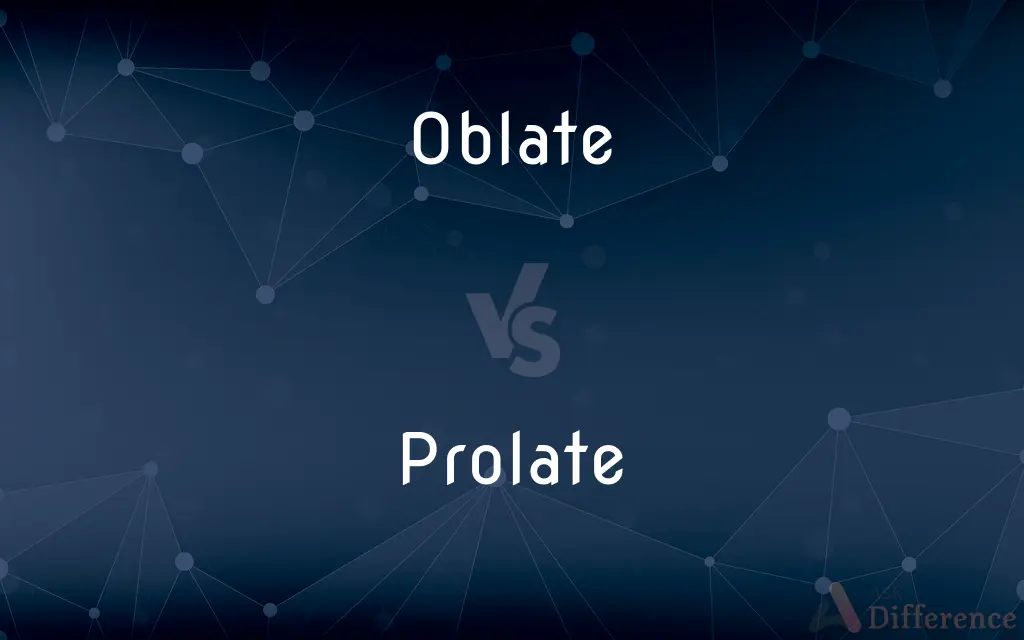Oblate vs. Prolate — What's the Difference?
By Maham Liaqat & Urooj Arif — Updated on April 7, 2024
Oblate spheroids are flattened at the poles, whereas prolate spheroids are elongated along the polar axis.

Difference Between Oblate and Prolate
Table of Contents
ADVERTISEMENT
Key Differences
Oblate spheroids are shapes formed by rotating an ellipse around its minor axis, leading to a flattened appearance at the poles. This shape is common in celestial bodies like planets, which often bulge at the equator due to their rotation. On the other hand, prolate spheroids are generated by rotating an ellipse around its major axis, resulting in a shape that is elongated along the polar axis. This form is less common in nature but can occur in rapidly rotating bodies or under specific gravitational conditions.
While oblate spheroids have a shorter polar axis compared to their equatorial diameter, prolate spheroids exhibit the opposite, with a longer polar axis than their equatorial diameter. This fundamental difference affects the distribution of mass and gravitational field around the objects.
In the context of geometry, oblate spheroids are described by two radii: a longer equatorial radius and a shorter polar radius, indicating a compression along the polar axis. Conversely, prolate spheroids have a longer polar radius and a shorter equatorial radius, highlighting an extension along the polar axis.
From an astrophysical perspective, the Earth is an example of an oblate spheroid due to its equatorial bulge caused by rotation. Meanwhile, certain types of rapidly rotating stars and some moons exhibit a prolate spheroidal shape due to the influence of tidal forces and rotational dynamics.
The study of oblate and prolate spheroids is crucial in various fields, including astrophysics, geophysics, and engineering, as understanding these shapes helps in modeling the behavior of planets, stars, and man-made structures under rotation and gravitational forces. While oblate shapes are more prevalent in our solar system, prolate spheroids provide unique insights into the dynamics of celestial bodies under extreme conditions.
ADVERTISEMENT
Comparison Chart
Axis of Rotation
Minor axis (shortest diameter)
Major axis (longest diameter)
Shape Appearance
Flattened at the poles
Elongated along the polar axis
Common Examples
Earth, Saturn
Some rapidly rotating stars, moons
Equatorial vs Polar Radius
Equatorial radius > Polar radius
Polar radius > Equatorial radius
Occurrence in Nature
More common in planets and stars
Less common, seen in specific cases
Compare with Definitions
Oblate
A shape formed by rotating an ellipse about its minor axis, resulting in a flattening at the poles.
Earth is considered an oblate spheroid because of its equatorial bulge.
Prolate
A shape generated by rotating an ellipse about its major axis, creating an elongation along the polar axis.
Some moons exhibit a prolate spheroid shape due to their rotational dynamics.
Oblate
The phenomenon where the equator is wider than the polar diameters due to rotation.
Saturn showcases a pronounced equatorial bulge, making it an oblate spheroid.
Prolate
Can be stable but may require specific rotational speeds or external forces to maintain shape.
A prolate spheroid’s shape can be stable if its rotational speed is balanced with its gravitational forces.
Oblate
Generally stable under rotation, with minimal changes in shape.
A rotating oblate spheroid, such as Earth, maintains its shape steadily over time.
Prolate
The condition where the length along the polar axis exceeds the equatorial diameter.
A prolate spheroid, under specific conditions, shows significant polar elongation.
Oblate
Slightly stronger at the poles due to the oblate shape.
The gravitational field of an oblate spheroid like Earth is stronger at the poles.
Prolate
Can have a more uniform field along the equator due to the elongated shape.
The gravitational field around a prolate spheroid can be more evenly distributed along its equator.
Oblate
Characterized by its equatorial and polar radii, with the equatorial radius being larger.
Measuring Earth reveals its oblate nature, with the equatorial radius significantly larger than the polar radius.
Prolate
Distinguished by its polar and equatorial radii, with the polar radius being longer.
The elongated nature of a prolate spheroid is evident when measuring its longer polar radius compared to its equatorial radius.
Oblate
In Christianity (especially Catholic, Eastern Orthodox, Anglican and Methodist), an oblate is a person who is specifically dedicated to God or to God's service. Oblates are individuals, either laypersons or clergy, normally living in general society, who, while not professed monks or nuns, have individually affiliated themselves with a monastic community of their choice.
Prolate
Having the shape of a spheroid generated by rotating an ellipse about its longer axis.
Oblate
Having the shape of a spheroid generated by rotating an ellipse about its shorter axis.
Prolate
Having the distance between the poles longer than the equatorial diameter
A prolate spheroid.
Oblate
Having an equatorial diameter greater than the distance between poles; compressed along or flattened at the poles
Planet Earth is an oblate solid.
Prolate
Elongated at the poles.
A cigar is a prolate spheroid.
Oblate
A layperson dedicated to religious life, especially such a layperson who is affiliated with but not a member of a monastic order.
Prolate
To utter; to pronounce.
Oblate
Oblate Roman Catholic Church A member of one of various religious communities whose members are bound by less stringent vows than those required of monastic orders.
Prolate
Stretched out; extended; especially, elongated in the direction of a line joining the poles; as, a prolate spheroid; - opposed to oblate.
Oblate
(Roman Catholicism) A person dedicated to a life of religion or monasticism, especially a member of an order without religious vows or a lay member of a religious community.
Prolate
To utter; to pronounce.
Oblate
A child given up by its parents into the keeping or dedication of a religious order or house.
Prolate
Having the polar diameter greater than the equatorial diameter;
A prolate spheroid is generated by revolving an ellipse about its major axis
Oblate
Flattened or depressed at the poles.
The Earth is an oblate spheroid.
Prolate
Rounded like an egg
Oblate
To offer as either a gift or an oblation.
Oblate
Flattened or depressed at the poles; as, the earth is an oblate spheroid.
Oblate
One of an association of priests or religious women who have offered themselves to the service of the church. There are three such associations of priests, and one of women, called oblates.
Oblate
A lay person dedicated to religious work or the religious life
Oblate
Having the equatorial diameter greater than the polar diameter; being flattened at the poles
Common Curiosities
Are oblate spheroids common in the universe?
Yes, many planets and stars are oblate due to their rotation.
What is the difference between the equatorial and polar radii in oblate and prolate spheroids?
In oblate spheroids, the equatorial radius is larger; in prolate spheroids, the polar radius is larger.
How do gravitational fields vary between oblate and prolate spheroids?
Oblate spheroids have stronger gravitational fields at the poles, whereas prolate spheroids may have more uniform fields along the equator.
What causes an oblate spheroid shape?
The rotation of a body around its minor axis, leading to a flattening at the poles.
How is the stability of a spheroid related to its rotation?
Stability can depend on the balance between rotational speed and the distribution of mass.
Can planets be prolate spheroids?
While less common, some planets or moons can exhibit a prolate shape due to extreme rotational dynamics or tidal forces.
Can the shape of a spheroid affect its orbit?
Yes, the distribution of mass and the gravitational field can influence orbital dynamics.
Are there any man-made objects designed as prolate spheroids?
Yes, some aerodynamic and hydrodynamic designs utilize the prolate spheroid shape for efficiency.
What role do tidal forces play in shaping spheroids?
Tidal forces can elongate a body in the direction of the gravitational pull, potentially leading to a prolate shape.
How does rotation affect the shape of a spheroid?
Rotation around the minor axis tends to flatten the poles (oblate), while rotation around the major axis elongates the poles (prolate).
Why is Earth considered an oblate spheroid?
Due to its equatorial bulge caused by rotational forces.
Can the shape of spheroids affect climate or weather patterns on planets?
Yes, the distribution of sunlight and atmospheric circulation can be influenced by the shape of the planet.
Can a spheroid's shape change over time?
Yes, due to tidal forces, rotational changes, or external impacts.
What measurements are important for identifying a spheroid’s type?
The equatorial and polar radii are key measurements.
How does a spheroid’s shape influence its gravitational pull?
The shape affects how mass is distributed, which in turn influences the gravitational field's strength and uniformity.
Share Your Discovery

Previous Comparison
Pessimism vs. Cynicism
Next Comparison
Incorporation vs. RegistrationAuthor Spotlight
Written by
Maham LiaqatCo-written by
Urooj ArifUrooj is a skilled content writer at Ask Difference, known for her exceptional ability to simplify complex topics into engaging and informative content. With a passion for research and a flair for clear, concise writing, she consistently delivers articles that resonate with our diverse audience.














































